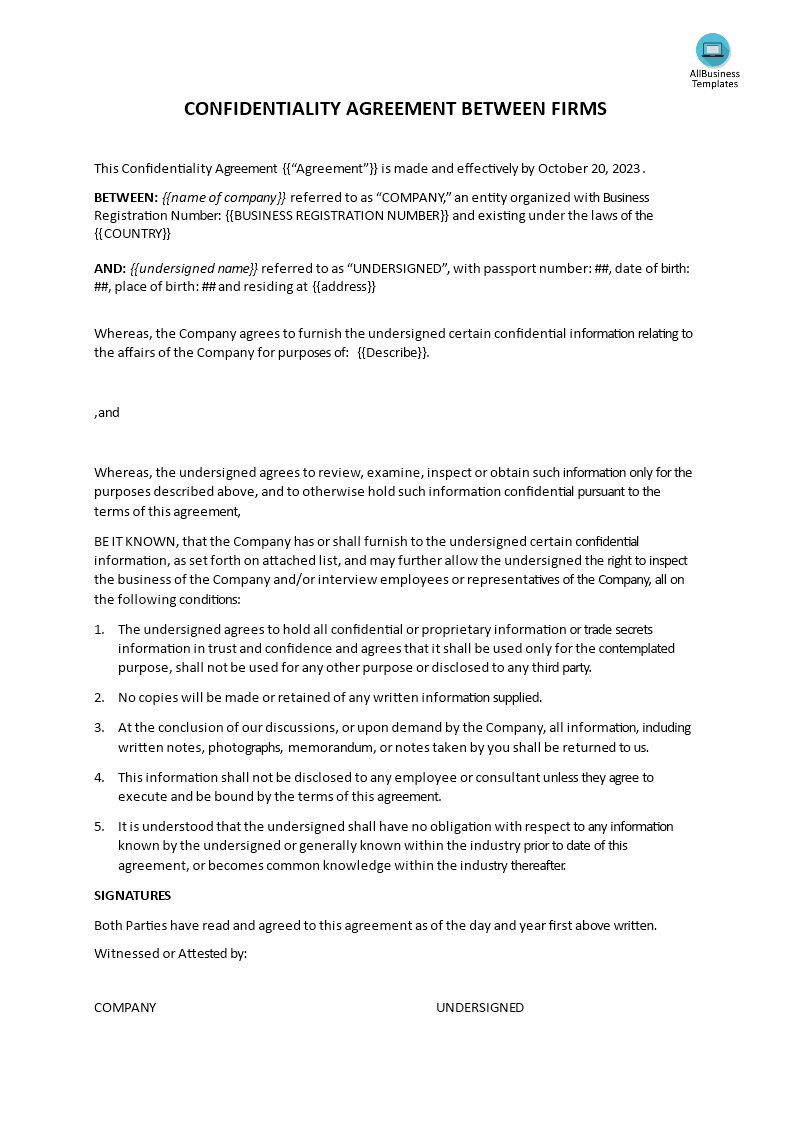Confidentiality agreement between firms
Save, fill-In The Blanks, Print, Done!

Download Confidentiality agreement between firms
Today: USD 5.99
Download It Now

Available premium file formats:
Microsoft Word (.docx)- This Document Has Been Certified by a Professional
- 100% customizable
- This is a digital download (24.63 kB)
- Language: English
- You will receive a link to download the file as soon as your payment goes through.
- We recommend downloading this file onto your computer.
Do you need to sign a Confidentiality agreement between two firms? What are the steps to writing a confidentiality agreement for a business? Our Confidentiality agreement template between firms is designed to protect confidential information shared between two entities. It outlines the obligations of each party, including the use of confidential information, and the consequences of any misuse. We provide a Confidentiality agreement template that suits your needs!
A Confidentiality Agreement (also known as a Non-Disclosure Agreement or NDA) between firms is a legally binding contract that establishes the terms and conditions under which two or more companies agree to share sensitive or confidential information with each other while ensuring that this information remains confidential and protected from unauthorized disclosure or use. Such agreements are common when firms need to collaborate, explore business opportunities, or engage in discussions that involve the exchange of proprietary or confidential information.
Here are the key elements typically found in a Confidentiality Agreement between firms:
- Parties: The agreement identifies the firms or organizations involved in the agreement, including their legal names and contact details.
- Definition of Confidential Information: The agreement defines what constitutes confidential information, which may encompass trade secrets, business plans, financial data, customer lists, product designs, technology, and any other proprietary information that the parties intend to share.
- Purpose: It outlines the specific purpose or reason for sharing confidential information. This section clarifies the context of the agreement, such as a potential business partnership, joint venture, investment, or collaboration.
- Obligations of the Receiving Party: The agreement specifies the responsibilities and obligations of the party receiving the confidential information (the recipient). These obligations typically include:
- Maintaining strict confidentiality.
- Using the information only for the agreed-upon purpose.
- Restricting access to the information to employees or agents who need to know.
- Taking reasonable measures to protect the confidentiality of the information.
- Non-Disclosure and Non-Use: The agreement explicitly states that the recipient will not disclose or use confidential information for any purpose other than the one specified in the agreement.
- Duration of Confidentiality: The agreement sets a time frame during which the recipient is bound by confidentiality obligations. This could be for a specified number of years or until a particular event occurs (e.g., the termination of discussions or the completion of a project).
- Permitted Disclosures: It may include exceptions that allow the recipient to disclose confidential information in certain situations, such as when required by law or with the written consent of the disclosing party.
- Return or Destruction of Information: Upon the conclusion of the agreement or when confidential information is no longer needed, the recipient may be required to return or destroy all copies of the information.
- Legal Remedies: The agreement typically outlines the legal remedies available to the disclosing party in the event of a breach of confidentiality. This may include injunctive relief, monetary damages, or other remedies available under applicable laws.
- Governing Law and Jurisdiction: It specifies the laws that will govern the agreement and the jurisdiction where any legal disputes related to the agreement will be resolved.
- Execution and Effective Date: The agreement is signed and dated by authorized representatives of the participating firms, indicating their acceptance of its terms and conditions.
Confidentiality agreements between firms are crucial for safeguarding sensitive information and building trust between parties engaged in business negotiations, partnerships, or collaborative efforts.
Download this professional Confidentiality agreement between two firms now!
For more business templates? Just browse through our database and website! You will have instant access to thousands of free and premium business templates, legal agreements, documents, forms, letters, reports, plans, resumes, etc., which are all used by professionals in your industry. All business templates are ready-made, easy to find, wisely structured, and intuitive.
DISCLAIMER
Nothing on this site shall be considered legal advice and no attorney-client relationship is established.
Leave a Reply. If you have any questions or remarks, feel free to post them below.
Related templates
Latest templates
Latest topics
- Excel Templates
Where do I find templates for Excel? How do I create a template in Excel? Check these editable and printable Excel Templates and download them directly! - GDPR Compliance Templates
What do you need to become GDPR compliant? Are you looking for useful GDPR document templates to make you compliant? All these compliance documents will be available to download instantly... - Google Docs Templates
How to create documents in Google Docs? We provide Google Docs compatible template and these are the reasons why it's useful to work with Google Docs... - IT Security Standards Kit
What are IT Security Standards? Check out our collection of this newly updated IT Security Kit Standard templates, including policies, controls, processes, checklists, procedures and other documents. - Letter Format
How to format a letter? Here is a brief overview of common letter formats and templates in USA and UK and get inspirited immediately!
cheese
